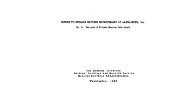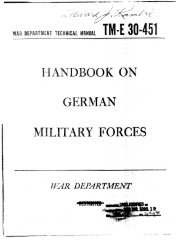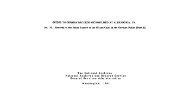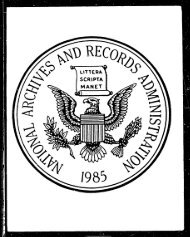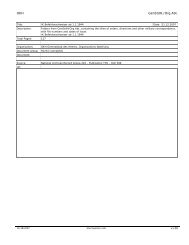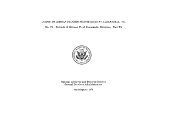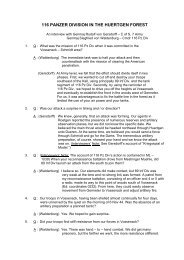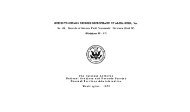(Construction detachment ^ approximately 100" to" 150" men, withHilfsarbeiter (auxiliary labourers) drawn from foreign personnel.Such construction detachments were classified as OT organicpersonnel. Their movements were controlled by the OT authoritiesof higher echelons (Einsatz HQ and upward) on the basis of a constructionprogramme as agreed upon between the OT and Army or AnnyGroup HQ. The number of such personnel on any one constructionsite depended on the size of the job. (The term Bautrupps fellinto gradual disuse, due to the mass influx of foreign workersinto the OT after the German victories of 1940/41, but it wasrevived shortly before D-day.)Unskilled manpower was provided in the form of eitherprisoners of war, locally hired or impressed, or occasionally RADpersonnel. Mention is made in secondary sources of Stellungsbau,Tiefbau, Feldbahn and Strassenbahn Bataillone (Constructionbattalions specialising in the building of fortified positions,tunnels, highways and railroads). No documentary evidence hasbeen found testifying to the existence of such units in the OT,however, and it is believed that the units involved were armyconstruction units and RAD units working with the OT.Not much i s known of the early organisation of the Servicessuch as transport, medical and so forth. It may be safely assumedthat they were both mobile and, to some extent, improvised to meetchanging requirements. Protection to installations and personnel,particularly in Russia and the Balkans, was afforded by the Schutzkomnando(SK: Security Guard) <strong>com</strong>posed of very small mobile contingents,so disposed as to be capable of quickly forming largerdefence units. Liaison was also maintained with Army and SS lineof <strong>com</strong>munications regiments in case of emergency.Local sectors, consisting of one or more construction sitesand hence of one or more construction firms, were controlled bythe local sectorOT HQ - usually an OBL. In the early days of theQT, the control of firms and firm personnel was much looser thanat present. The main reason lay in the economic protectionafforded OT-f irms by the powerful German Construction Industry ascontrasted with the <strong>com</strong>paratively lax administration by the GeneralInspector des Deutsche Strassenwesen (Inspectorate General ofGerman Roadways). The period from mid-year I941 to mid-year 1942was a period of transition in respect to <strong>com</strong>position of personnel.The Balkan campaign and the first phase of the Russian campaignresulted in the employment by the OT of a vast number of Russiansand a proportional number of Serbs, Greeks, and so forth; inaddition Hungarian and Rumanian Engineer, or more aptly, Labourbattalions, provided another source of manpower in Russia. WhenSFEER took over control of theOT upon TODT' s death in February1942, he incorporated his Baustab SPEER with a strength of100,000 into the 0T 9 in the Crimea. (The Baustab had been buildingaerodromes for the German Air Force. Subsequently it had movedinto the Crimea to perform tasks similar to those of the OT). TheNSKK-Transport Brigade TODT was also activated in order to takecare of transport. The entire OT manpower strength in March 1942i s estimated at approximately one million men.111. "Stable" Period, 1942/44 (Foreign Labour, Kolonnen,Hundertschaften or Bereitschaften and Abteilungen).About the middle of 1942 a defensive policy became evident inGerman military strategy. Fortifications on a vast scale began tobe built in Russia, Norway and Western Europe. OT Zentrale (OTZ:OT Central HQ) in BERLIN, which had begun to make its central controlfelt especially in the West by establishing operational sectorsthere on a "permanent" basis, began systematically to co-ordinate-118
ar T—all phases of OT operation. At the same time, the OT began torecruit manpower in earnest in the occupied territories. In_tneWest and in Norway, manpower, much of it skilled or sm^-^UJ.^*were recruited locally and put to work on the massive fortifications.This was augnented by mass transfers of unskilled workers, mostlyPoles and Russians, from the East.Contractual relations between the OT and OT-f irms werestabilised, and uniform regulations were isaued on a <strong>com</strong>prehensivescale which the firms were expected to follow. By this time theproportion of Germans to foreigners had dropped to less than lO^S,and a uniform pay tariff, applicable to all OT personnel exceptZirangsarbeiter (Forced Labour), was issued in June 1942, *o be<strong>com</strong>eeffective Jamary 1943. The status of OT personnel as militia wasmore strongLy established than i t had been heretofore aroundJamary 192*3 by substituting the phrase ^ehrmachtangehttrige* 1(member of the Vehrmacht) far the term "Wehmachtsgefolge" in theDienstbflcher (pay and Identity Books).If all the manpower which worked for the OT directly orindirectly, in the early part of 1943, is calculated, the figuremay well reach the neighbourhood of two million, mostly locatedoutside the Reich. In the winter of 1941/45, before the currentAllied advances into Germany, it is estimated to have dropped toabout one million, mostly inside the Reich. A further step inregimenting manpower was taken in March 1944 when all foreignlabour was partitioned into units of 20 men called M Kolonnen w ,units of about 125 called "Bindertschaften" or "Bereitschaften",and - sometimes - into units of 250 called "Abteilungen". Theseformed the vast bulk of OT labour and included the Zwangsarbeiter(Forced Labour), mostly Russians and Jews (See inBbll9-122). Theterm Bautrupps which had ceased to exist after the dissolution ofthe early German construction detachments, was revived some weeksbefore D-day (See IAZ3 and XB16) .• w112. Current developments (Front-QT. OT Legionare, Special Brigades,Russian Units).When the OT evacuated oooupied territory and withdrew intoGermany in the simmer and autumn of 1944, seme of its personnellost their standing as Frontarbeiter (Front zone workers) insofaras their new location took them into an interior zone in Germany.On the other hand the term Front-OT was created to designate aforward area in which OT personnel retained their standing asFrontarbeiter (or OT Legionare in the case of foreign collaborationists). Simultaneously with the creation of the n Front-0T n ,special OT units were activated and formed, along military lines,i.e., Brigades. Regiments, Battalions and Companies. Two OT regimentshave so far Been identified (see IIIBbl23), but it is doubtfulwhether the entire formation, planned at 30,000 highly skilledmen with sufficient equipment for three times that number, has beenactivated. Thia development has been more fully discussed inIB17,18 and 20. Another current development of similar nature i sthe incorporation into the OT of the Russian military unitsrecruited by General VLJlSSOV. This step seems to have been takenin March 1945 (see IVBj).U3 .Composition of OT Personnel, with the Exception of Mania!Labourers", in an OBL sector.The staff of a basic construction sector (OBL) oan be brokendown «a follows ;OT-eigenes Personal (OT organic Personnel);* For <strong>com</strong>position of manual labourers see IIIBbll9-123.-119
- Page 1 and 2:
IR5/f!lR-0T/5/4SHRnDBOOK OF THEDRcn
- Page 3 and 4:
GE R MAN YOT EINSATZGRUPPEN, AUTUMN
- Page 5 and 6:
TABLE OP CONTENTS(See also LIST OP
- Page 7 and 8:
4a. OrganizSferiy %f Sfciw t>T& ^ ^
- Page 9 and 10:
Page35. "Current Organization" Eins
- Page 11 and 12:
155» Miscellaneous Deductions and
- Page 13 and 14:
To-day PT is indispensable in any p
- Page 15 and 16:
UNCLASS13* The two "basic types 6_
- Page 17 and 18:
of control over its plans, which we
- Page 19 and 20:
OT units was that of Bautrupps (Con
- Page 21 and 22:
__ n be committed to work by order
- Page 23 and 24:
11. OT Construction Activities 1942
- Page 25 and 26:
In case of Allied landings. In the
- Page 27 and 28:
Factors militating against complete
- Page 29 and 30:
1* Rationalization^ on a nation wid
- Page 31 and 32:
The project itself cannot be accept
- Page 33 and 34:
areas within the Reich; (3) Einsatz
- Page 35 and 36:
has the final responsibility for me
- Page 37 and 38:
Matters of policy, as decided upon
- Page 39 and 40:
with the Wehrmacht and with civil a
- Page 41 and 42:
which do the actual work. This is o
- Page 43 and 44:
adjacent construction sites are gro
- Page 45 and 46:
Amt Bau-OTZ.The second ia the auton
- Page 47 and 48:
are to be employed in tha execution
- Page 49 and 50:
"Current Organization" Bauleitung (
- Page 51 and 52:
Former Hauptabteilungen in OTZ have
- Page 53 and 54:
(SS Liaison Officer) are the follow
- Page 55 and 56:
y the Array for the construction of
- Page 57 and 58:
fortresses stretch over its entire
- Page 59 and 60:
(Eastern Wall) in April 1943* At on
- Page 61 and 62:
obviously would also have the same
- Page 63 and 64:
Consequently ten lype A emplacement
- Page 65 and 66:
at the expense of the "private comm
- Page 67 and 68:
eside those of feeding and billetin
- Page 69 and 70:
57* Construction Programme, Materia
- Page 71 and 72:
Italian firms arid the workers is c
- Page 73 and 74:
"The large scale construction work
- Page 75 and 76:
Diplom - Ingenieur "* Paul ANDORY,
- Page 77 and 78:
Para. 7 ~ CompensationCompensation
- Page 79 and 80: Para* 16 - Text of the ContractThe
- Page 81 and 82: m tag » * u »"5. For ascertaining
- Page 83 and 84: - Delivery of Building MaterialThe
- Page 85 and 86: prior consent of the HU. Any assign
- Page 87 and 88: ecause of Allied propaganda and the
- Page 89 and 90: all replacement parts of machine we
- Page 91 and 92: served only as a general directive.
- Page 93 and 94: The transport organizations forking
- Page 95 and 96: outside the "boundaries of the Reic
- Page 97 and 98: d) Health and Medical Services77. M
- Page 99 and 100: tfhTheading "identifying scars or w
- Page 101 and 102: example, units of the Feldgendanaer
- Page 103 and 104: set up within the region of each Ar
- Page 105 and 106: Sc^al Festungspionier stab, (Portre
- Page 107 and 108: Refer at (Sub Unit) BII1 : Hochbau,
- Page 109 and 110: 2. Although the agencies are subord
- Page 111 and 112: Emergency Measures1. In case of imm
- Page 113 and 114: The interests of the OT firms as an
- Page 115 and 116: of the OBL cuts across two or more
- Page 117 and 118: The following captured document, he
- Page 119 and 120: sche Nothilfe - Technical Tanarfien
- Page 121 and 122: Chef de¥iflitfSItverwaltung, Haupt
- Page 123 and 124: corresponding in area to the DHL's.
- Page 125 and 126: ij Feldpoli^ei (commonly abbreviate
- Page 127 and 128: erNSKK Verbindungsf&hrer des Transp
- Page 129: , _ .-^^-^^-^sson of aDienstbuch (P
- Page 133 and 134: B. Classicioation of Personnela) Ge
- Page 135 and 136: Control during working hours - unde
- Page 137 and 138: ii . Betriebsftihrer (Finn Manager)
- Page 139 and 140: vii,obhoer*ed. In the performance o
- Page 141 and 142: were supposed to b« numbered conse
- Page 143 and 144: In the autumn of 192*4, co-operatio
- Page 145 and 146: with the French Betreuungftthrer me
- Page 147 and 148: C; Training.129. Military Training.
- Page 149 and 150: Russians also received this trainin
- Page 151 and 152: NCO in OT - Dienst Unifom wearing M
- Page 153 and 154: only distinguishing feature being t
- Page 155 and 156: Dr. Pritz Todt Ehrennadel in Gold (
- Page 157 and 158: ff f^f(b) * OT-Eigenes Personal (OT
- Page 159 and 160: (v)the same*In December 1944, howev
- Page 161 and 162: "IT "BT •CTGefcaltsgruppe I. 2 On
- Page 163 and 164: untranslated and may be checked in
- Page 165 and 166: Up to this point OT tariffs affecti
- Page 167 and 168: a|t|jr^|| h l^fcers are paid accord
- Page 169 and 170: ftfonthlv Einsatz Pav forMarried Wo
- Page 171 and 172: IpecTaj regulations affecting OT pa
- Page 173 and 174: or.- soid(Wehrsold) G. Gouv. Russ
- Page 175 and 176: or negligence:time lost because of
- Page 177 and 178: ^rfrom service in the OT, the worke
- Page 179 and 180: MANPOWERA. General Manpower Statist
- Page 181 and 182:
162. FirmenangehgrJRe (OT»-Firm Pe
- Page 183 and 184:
x» , ~«^«u u*^ of 1942, irregula
- Page 185 and 186:
The nuSKF'Wf s&lfeifrms 1 is estima
- Page 187 and 188:
equally urgent rSeP^^irniShing Germ
- Page 189 and 190:
Orders had come through to class ev
- Page 191 and 192:
The Gorman Feldkommandanturen who w
- Page 193 and 194:
Baltic Manpower179* Proportion and
- Page 195:
and to a lesser_. —ii«i4lfiU&»




